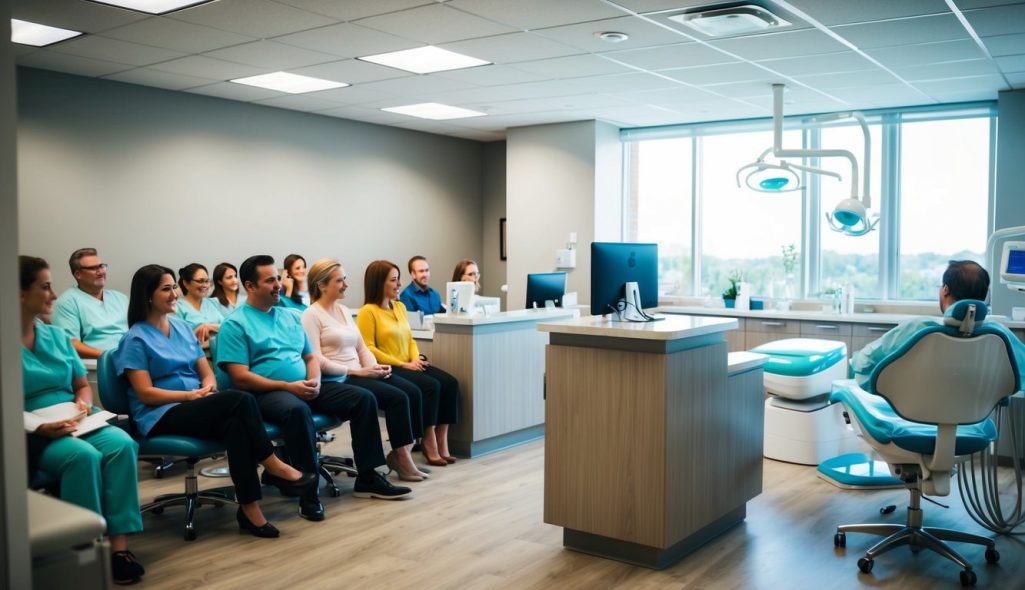Email marketing can be a powerful tool for dental practices aiming to attract and keep patients. With email, you can directly connect with your patients, providing updates, tips, and promotions straight to their inboxes. Email marketing helps you grow patient loyalty and boost referrals by creating personalized connections with your audience.

Crafting effective email content is key to engaging your patients. You want to make sure you include helpful information that addresses their needs and interests. This might involve sending reminders for regular check-ups, sharing dental care tips, or offering special promotions. By doing this, you establish trust and reinforce your practice’s presence in their lives.
Email marketing also includes strategies like segmentation and personalization, allowing each message to feel tailor-made. Automation makes it easy by scheduling emails to go out at optimal times, ensuring they reach patients when they are most likely to read them. Measuring success through key metrics helps refine your approach, so your efforts yield the best results for your practice’s growth.
Key Takeaways
- Email marketing builds patient loyalty and increases referrals.
- Engaging content and personalization are crucial for success.
- Use automation and metrics to enhance your strategy.
Understanding Email Marketing for Dentists
In the realm of dentistry, email marketing is an essential tool to engage with patients effectively and boost your practice’s visibility. It is crucial to clearly outline your marketing goals and understand how digital marketing can enhance your dental services.
The Importance of Digital Marketing in Dentistry
Digital marketing plays a crucial role in how dental practices reach and retain patients. Through email marketing, you can maintain regular contact with your patients by sending newsletters, appointment reminders, and special offers. This communication keeps your practice at the forefront of their minds.
Email marketing allows you to segment your patient list into groups based on their needs and preferences. You can tailor messages to different demographic segments, making them more personalized and relevant. This customization can lead to higher engagement rates.
Implementing an email strategy can be cost-effective, especially when compared to traditional marketing methods. You can easily track open rates, click-through rates, and conversions, allowing you to measure the effectiveness of your campaigns and make informed adjustments. Learn more about why digital marketing is effective for dentists.
Defining Your Marketing Goals
Before launching any campaign, it’s important to define clear marketing goals. Start by identifying what you want to achieve, such as increasing patient appointments, promoting new services, or enhancing patient engagement. These goals will guide the structure of your emails and the type of content you’ll include.
Think about who your target audience is and what kind of information they find valuable. By creating detailed patient personas, you can craft messages that address specific needs and interests. For example, you might develop newsletters focused on dental hygiene tips or updates about dental technology advancements.
It’s important that your goals are measurable and time-bound. You might set a target to increase patient appointments by 15% over three months. Having clear objectives allows you to track progress and modify strategies when necessary. For more insights, explore tips on implementing dental email marketing strategies.
Building a Targeted Email List
Creating a targeted email list is essential for effective email marketing in dentistry. This involves managing your list well, drawing in new patients, and keeping their information private and secure.
Email List Management
Managing your email list is crucial to ensure you connect with the right people. Use an email marketing platform that offers tools like segmentation and analytics. These features help you organize your contacts based on factors like location, treatment preferences, or appointment history.
Regularly update your list by removing inactive emails and adding new contacts. This keeps your communication relevant and minimizes unsubscribes. An organized list also allows for more personalized messaging, ensuring that the content you send is appealing to your target audience.
Attracting New Patients
To grow your email list, focus on attracting new patients. Offer incentives such as discounts or free consultations when they sign up for your emails. Ensure your sign-up process is easy and accessible, like having a sign-up form on your website or at your office.
Personalized campaigns help engage potential patients, increasing the chances they will subscribe. Utilize social media and online reviews to highlight patient success stories, encouraging others to join your list. Remember, the goal is to build a community of interested patients eager to receive your updates and offers.
Ensuring Patient Privacy and Consent
Securing patient data is essential when building your email list. Make sure to comply with legal regulations by obtaining explicit consent from patients before adding them to your list. Clearly explain how their information will be used and offer details about email frequency. Include an easy option for patients to unsubscribe at any time. This builds trust and respect with your audience, enhancing the credibility of your practice.
Protecting data with robust security measures not only meets legal standards but also reassures patients that their privacy is a priority.
Crafting Effective Email Content
Creating engaging content is vital for email marketing success. You’ll learn how to write emails that promote your dental services, offer valuable education on oral health, and keep your patients informed through regular updates.
Promotional Emails and Special Offers
Promotional emails play an important role in increasing patient visits to your dental practice. When crafting these emails, highlight special offers or discounts clearly. Use bold text for promotions to draw attention. Including limited-time offers can create a sense of urgency, encouraging quick responses.
Personalize your messages by addressing patients by name. Segment your email list to target specific groups with relevant offers. For example, remind families about back-to-school dental check-ups or offer discounts during the holiday season. Use appealing images and clear call-to-actions to make these emails more effective.
Educational Content and Oral Hygiene Tips
Educational content builds trust with your patients by providing them valuable insights into oral health. Share tips on daily dental care, like proper brushing techniques and the importance of flossing. Explain common dental issues and how to prevent them using bullet points for clarity.
Consider creating a series on oral hygiene tips or common dental myths. Videos or infographics can make information more digestible. Encourage reader interaction by inviting questions or suggestions for future topics. This type of content strengthens patient relationships by showing your commitment to their dental health.
Newsletters and Updates
Newsletters are an excellent way to keep your patients informed about the latest happenings in your practice. Include updates about new services, staff introductions, or changes in office hours. A consistent newsletter schedule helps maintain regular communication with your audience.
Make your newsletter visually appealing with a simple layout and engaging images. Use tables to organize any scheduling or event information for easy reading. Incorporate patient success stories or testimonials to build community and trust. Newsletters should reflect your practice’s personality while staying professional and informative.
Segmentation and Personalization
Segmentation and personalization are key strategies in email marketing for dentists. Organizing your patient list based on specific criteria can lead to better communication. Personalizing emails strengthens relationships with your patients.
Targeting the Right Audience
Focusing on the right segments helps you send relevant messages. You can segment your email list by patient demographics, appointment history, or specific dental treatments. For instance, if you have patients who frequently visit for teeth cleanings, you might create a segment for them to receive special offers related to hygiene products.
Effective segmentation involves using tools like analytics to gain insights into patient behaviors and preferences. This approach boosts the relevance of your emails and increases the likelihood of engagement. For more detailed strategies on mastering segmentation, consider reading more.
Personalized Emails for Patient Engagement
Personalized emails make patients feel valued and understood. Start by addressing patients by name and including details like previous treatments. This shows attention to their unique dental history and needs.
You might also wish patients a happy birthday or remind them of an upcoming check-up with a friendly note.
Sending emails at the right time can also enhance connection, such as offering tips on oral health at the beginning of the year. This kind of personalization improves patient satisfaction and loyalty. To explore more about crafting effective personalized emails, you can refer to this comprehensive guide.
Automation and Scheduling
Automating your email marketing efforts can save time and enhance efficiency. By effectively using automation, you can improve patient communication, reduce no-shows, and boost customer retention.
Appointment Reminders and Scheduling
Appointment reminders are crucial for keeping your dental practice running smoothly. Automating reminders helps ensure your patients don’t miss their appointments, reducing no-shows and cancellations.
You can set up reminders to be sent via email automatically days before the appointment, which makes scheduling more streamlined.
Creating reminders that include the appointment date, time, and any necessary preparation tips can improve your practice’s efficiency. Moreover, including a link for patients to easily reschedule or confirm, like those offered by various email marketing platforms, can further assist in managing your calendar effectively.
Automated Welcome Emails
Sending a welcome email is a simple yet effective way to introduce new patients to your dental practice. Automated welcome emails can provide information about the office, services offered, and what patients can expect on their first visit.
These emails serve as an opportunity to establish rapport and begin building a relationship with patients. Including links to patient forms or an introduction to the dental team can enhance their experience. Automating this process ensures every new patient receives a consistent welcome message, improving patient satisfaction from the very start.
Follow-up and Feedback Requests
Follow-up emails are vital for maintaining communication and ensuring patient satisfaction. After a dental visit, automated follow-up emails can be used to thank patients for their visit and invite them to provide feedback.
By integrating feedback requests, your practice can gain valuable insights into how services are perceived and identify areas for improvement.
Including a survey link or a direct way for patients to rate their visit can encourage participation. Regular follow-ups help keep your practice at the forefront of patients’ minds, increasing the chances of them scheduling future appointments and enhancing customer retention.
Measuring Email Marketing Success
To gauge the success of email marketing efforts for dental practices, focus on key metrics and testing strategies to refine and improve your campaigns. Monitoring open rates and click-through rates, conducting A/B testing, and examining return on investment are essential steps.
Tracking Open and Click-Through Rates
Open rates indicate how many recipients opened your emails. A high open rate can show that your subject line and timing are effective.
You can improve these rates by personalizing subject lines and sending emails at optimal times.
Click-through rates measure how many recipients clicked on links within the email. This metric helps assess the interest in the content.
To boost click-through rates, include compelling calls-to-action and make sure the email content aligns with reader interests.
Regularly analyzing open and click-through rates helps you identify trends and areas for improvement. This data-driven approach aids in optimizing future campaigns, enhancing patient engagement over time. For detailed insights on tracking these metrics, you can explore this guide.
A/B Testing for Optimizing Campaigns
A/B testing involves sending two versions of an email to see which performs better. This method helps refine your approach by comparing different subject lines, content, or visuals.
By testing one element at a time, you can identify which changes impact recipient behavior the most.
Through A/B testing, you can learn what resonates with your audience and which factors drive higher engagement. This can lead to more efficient use of your marketing budget.
Consistent testing and analyzing results can pinpoint what tweaks are beneficial to your campaigns. Check out this step-by-step guide for launching effective email campaigns.
Analyzing Return on Investment
Understanding the return on investment (ROI) of your email marketing campaigns is crucial for determining their effectiveness. You can calculate ROI by comparing the revenue generated from email marketing to the cost invested in these efforts. This helps assess if your marketing budget is being used wisely.
Focusing on ROI ensures that your campaigns are not only engaging but also financially beneficial. It allows you to allocate resources better and prioritize strategies that yield the most profit. Monitoring ROI regularly can guide future marketing decisions and maximize overall practice success.
Enhancing Patient Loyalty and Referrals
Building patient loyalty and encouraging referrals are crucial strategies in growing a dental practice.
By focusing on gathering and leveraging online reviews, rewarding patient referrals, and improving overall patient satisfaction, you can effectively enhance these important aspects of your dental practice.
Leveraging Online Reviews
Online reviews play a vital role in shaping your dental practice’s reputation. To encourage satisfied patients to leave reviews on platforms like Google or Healthgrades, you should ask them directly.
Then, make sure to respond promptly to both positive and negative reviews to show your commitment to patient feedback.
By maintaining a high rating, potential patients are more likely to choose your practice. Regularly sharing positive reviews on your social media or website can provide additional credibility and improve trust.
Implement systems that remind patients to leave reviews after appointments, such as automated follow-up emails, to boost your online presence actively.
Rewarding Patient Referrals
Patient referrals are a cost-effective way to bring in new clients. So, establishing a referral program that rewards existing patients for referring friends or family is a great idea.
Rewards can include discounts on services, gift cards, or dental care products. Make sure to communicate this program clearly, so your patients know the benefits.
Ensure the rewards are meaningful enough to encourage participation. Consider featuring this program on your website or mentioning it during patient check-ins.
Be consistent in acknowledging and thanking patients who participate in referrals to make them feel appreciated and encouraged to refer more people.
Improving Patient Satisfaction
Patient satisfaction is the foundation of loyalty. Thus, you should focus on creating a welcoming and comfortable environment.
Training staff to be attentive and caring, as positive interactions can significantly impact patient experiences, is also important.
Lastly, assess satisfaction through surveys after appointments to gather insights into areas that need improvement.
Address concerns promptly to show patients that you value their input. Implementing feedback can lead to better service quality, ensuring patients feel heard and respected.
High satisfaction rates often lead to repeat visits, stronger patient-practitioner relationships, and increased likelihood of referrals. By actively improving satisfaction, you cultivate an environment that encourages loyalty and fosters trust within your practice.
Optimizing Your Email Marketing Strategy
To enhance your email marketing efforts, focus on integrating your campaigns with your broader strategies. Continuously seek growth by adapting to industry trends and improving based on feedback.
Aligning Email Campaigns with Overall Marketing Strategy
Aligning your email marketing strategy with your entire marketing approach is crucial. Ensure your email content reflects your practice’s goals and branding.
Consistency in tone and style strengthens recognition. Additionally, consider your target audience and their preferences by segmenting your email list. This boosts engagement.
Use insights from previous marketing campaigns to shape your email topics and schedule, ensuring they support your larger goals. Coordinating offers or announcements in emails with other platforms ensures a unified message, maximizing reach and influence.
Ongoing Strategies for Growth
For continuous growth, regularly reassess your strategy.
Start by employing A/B testing to determine what resonates with your audience. Then, experiment with subject lines, formats, and send times.
Implement automation to maintain consistent communication, like setting up triggers for reminders or follow-ups.
Monitor key metrics like open rates, conversions, and unsubscribe rates to gauge performance. Use these metrics to fine-tune email campaigns and address any weaknesses.
Collaborate with your team to brainstorm innovative ideas and capitalize on successful strategies. Staying informed about industry trends and adapting swiftly keeps your practice growing.
Adaptation and Continuous Improvement
Adapting and continuously improving your email marketing strategy is essential to remain effective.
To start, analyze feedback from patients regularly to understand their needs and preferences. Then, use this insight to make your email content more relevant and engaging.
Stay updated on new email marketing tools and technologies, like tools for enhanced personalization or interactive content, to keep your campaigns fresh.
Be open to changing tactics that don’t yield desired results. Adaptation ensures that your emails stay compelling and useful to your audience.
Lastly, prioritize training and development to keep your team skilled and responsive to changes.
Setting the Foundations for Brand Recognition
Building a strong and recognizable brand is key to standing out in the dental market. This involves creating a unique identity and ensuring consistency across various marketing platforms.
Establishing a Recognizable Dental Brand
You need to create a dental brand that sticks in people’s minds. Start by defining what makes your dental clinic different. Is it the friendly service, cutting-edge technology, or convenient location?
Design a logo and choose colors that reflect your clinic’s values. This visual identity should be simple, memorable, and professional. Make sure it appears on all marketing materials, from business cards to email newsletters.
Furthermore, craft a tagline that captures the essence of your dental practice. A clear and concise message can help solidify your brand’s presence.
Consistency Across Marketing Channels
To strengthen brand recognition, consistent messaging is critical. Ensure your dental clinic maintains a uniform look and feel across all platforms. This includes your website, social media, and printed materials.
Develop a marketing plan that outlines your brand’s voice. Is it casual and friendly or more formal and professional? Stick to this tone in all communications with patients.
Regularly update your marketing strategies to reflect any changes in your practice. This keeps your brand fresh and relevant. Remember, consistency not only fosters familiarity but also builds trust and loyalty among your patients.
Frequently Asked Questions
When it comes to email marketing for dentists, it’s important to focus on crafting effective campaigns, designing engaging content, and complying with privacy regulations. Here are some common questions answered to help you enhance your dental practice’s email marketing efforts.
What are the best practices for creating effective email marketing campaigns for dental practices?
To create a successful email campaign, start by setting clear goals. Segment your email list based on patient needs and interests.
Then, personalize your messages, and use a friendly yet professional tone. Lastly, regularly monitor your email metrics to understand what works best for your audience.
How can I design engaging email content to attract new patients for my dental clinic?
Designing engaging content starts with a strong subject line that grabs attention. Use visuals like images or videos to make your emails inviting.
Include informative content that educates patients about dental care. Keep messages concise and end with a clear call-to-action to encourage patients to book an appointment or learn more.
What are the key elements to include in an email marketing template for a dental office?
Your email template should include your dental office’s logo, contact information, and a link to your website. Include a section for special offers or promotions.
Always have a clear call-to-action button. Use a consistent color scheme and layout to align with your brand identity.
Which strategies should dentists use to increase the open and response rates of their marketing emails?
Improve open rates by personalizing subject lines and segmenting your audience. Send emails at optimal times when patients are likely to check their inboxes.
Engaging content and an enticing preview text can also increase curiosity, leading to higher open rates.
How often should dental practices send marketing emails to their patients to be effective but not intrusive?
Finding the right frequency is key. Sending one to two emails per month is generally effective without being overwhelming.
Adjust frequency based on patient feedback and engagement. Regularly review your analytics to ensure your emails are well-received and not marked as spam.
What measures can dentists take to ensure their email marketing complies with HIPAA and other privacy regulations?
Dentists can ensure their email marketing complies with HIPAA by avoiding including personal health information in emails. They should also use secure email platforms with encryption features. Additionally, they should always seek patient consent before sending emails and include options for patients to update their preferences or opt out. Lastly, they need to regularly review privacy policies to stay compliant with regulations.





